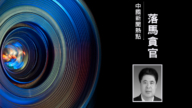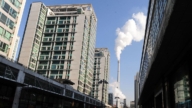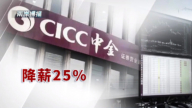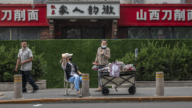【新唐人2011年3月22日讯】中国人民银行宣布,3月25号起,将上调存款准备金率0.5个百分点,这也是中国今年以来的第三次上调存准率。上调后大型金融机构的存准率将达到20%,中小机构则为16.5%,几乎达到了极限。巿场预期,在通胀问题依然严重下,升息的脚步不远了!但专家忧心,升息将导致人民银行的负债问题越来越沉重。
人民银行宣布将上调存款准备金率0.5个百分点。据估计,这将冻结约3600亿元的银行资金,减少约50亿元的净利息收入。
《路透社》19号报导,中国2月份“消费者物价指数CPI”仍居高不下,同比上涨4.9%。而“生产者价格指数PPI”同比也上涨了7.2%,创近两年半以来新高。
中国光大银行宏观经济分析师盛宏清博士认为,目前中国通货膨胀的压力还是很大,上半年CPI可能突破5%,巿场预期会有新一轮紧缩政策,人民银行将进一步加息。
这个月18号,英国《金融时报》中文网特约撰稿人陈绍霞在专文中指出,中国商业银行的存贷比上限为75%,因为2009年以来商业信贷规模快速增长,一些商业银行的存贷比不断上升,纷纷逼近甚至超过75%的安全上限。
理论上,“存款准备金率”的最高上限为25%。也就是银行吸收的存款75%用来发放贷款,25%用来上缴存款准备金。但如果除了贷款外,其他全部用于上缴法定存款准备金,银行将面临流动性风险。因此存准率的上限约为20%至22%。再上调存准率的空间已有限。巿场预测,加息将成为接下来抑制通胀的主要手段。不过专家忧心,加息将导致人民银行负债的成本上升。
专文指出,中国持有的巨额外汇储备余额常被理解为拥有巨额财富,但人民银行其实也背负着巨额的债务。2010年底,中国外汇储备余额为28,473亿美元,从资产负债表可以看出,2010年底,人民银行的总资产25.93万亿元,其中外汇资产折合人民币20.67万亿元,自有资金只有219.75亿元人民币,如果把它理解为净资产,人民银行的负债率将高达99.1%。而人民币持续升值,等于是外汇资产持续贬值。
人民银行持有的外汇资产,以美国、欧洲、日本等国国债和银行存款为主,2008年金融危机以来,各国利率降到历史最低水准,因此外汇收益率大幅下降,但以人民币计算的负债成本却不断上升。因为利率每上升1%,人民银行的利息支出将增加约2000亿元。因此,陈绍霞认为,人民币一次性大幅升值的可能性很小,比较可能采渐进方式升值。他还表示,在未来相当长的一段时间里,中国社会恐怕难以摆脱这种“实际利率仍将处于负利率状态”。
新唐人记者曾耀贤、李月综合报导。
China Bank More Indebted?
People’s Bank of China announced an increase
of deposits held in reserve by 0.5%, to 20%.
This is the third time the ratio is raised this year.
For smaller institutions, the ratio is 16.5%.
This means interest rates will rise soon.
Experts worry the bank will be more indebted.
People’s bank will raise the reserve ratio by 0.5%.
This will lock up RMB 360 billion,
and reduce interest income by RMB 5 billion.
According to Reuters, in February,
China’s consumer price index (CPI)
was 4.9% higher than the same period last year.
Producer price index (PPI) is 7.2% higher.
Macro-economist, Sheng Hongqing, said China’s
inflation pressure is high and CPI may reach 5%
by July. Fiscal policy may tighten,
and interest rates may rise.
A Financial Times article points out that
commercial banks set the limit of 75%
as the ratio of deposit that can be used for loans.
Commercial loans increased rapidly since 2009,
and some banks raised the deposit loan ratio
to approach the 75% critical limit.
Theoretically, upper limit for reserve ratio is 25%.
Banks can use 75% of deposits in loans,
and 25% in reserve. But to maintain cash flow,
banks cannot use all non-loan funds for reserve.
So reserve’s upper limit should be 20-22%.
China Bank has little room to raise reserve ratio.
Raising interest rate will be used to deter inflation,
and the bank will incur further debt.
China’s huge foreign reserve is often seen
as an asset, but Chinese banks also owe huge debts.
In 2010, China’s foreign reserve
was US$2847.3 billion. People’s Bank’s total assets
were RBM25.93 trillion, including foreign assets
of RMB 20.67 trillion. If its own fund
of RMB 21.975 billion is net asset, People’s Bank’s
debt ratio must have been 99.1% in 2010.
RMB appreciation will devalue foreign asset.
People’s Bank has assets in the U.S., Europe
and Japan, where interest rates are
the lowest in history. Each 1% increase
in interest rate will mean adding a
RMB 200 billion debt to People’s Bank.
The Financial Times article believes
RMB will appreciate slowly in the near future,
and the de facto interest rate will remain negative.
NTD Reporters Zeng Yaoxian and Li Yue




























